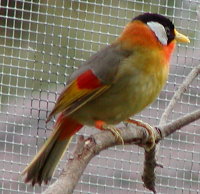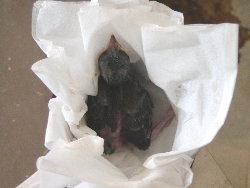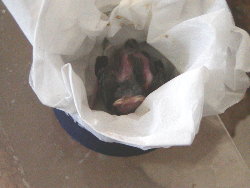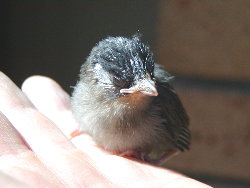
The Mesia Story.
|
|
|
Fig.1. Adult Male Silver-eared Mesia. |
Well, if you were expecting an article full of growth rates, anatomical measurements, feeding regimes and quantities you are going to be solely disappointed. For, in a scenario all too familiar to the bird keeper, this ‘project’ began out of necessity rather than as a scientific experiment. You know the story line, birds hatch chicks, birds feed chicks, birds find better things to occupy their time and turf afore mentioned chicks onto the aviary floor.
However, before launching into this nerve racking episode I should digress (this early I hear you say!!) and let you meet the species in question. The star of our story is the Silver –eared Mesia (Leiothrix argentauris) that hails from Nepal, Western China, through Indo China, Sumatra and Parts of Malaysia. As the Himalayan mountains occur in their range they are pretty tolerant of cold Tasmanian conditions from all accounts. Mesia’s are a close relative of the Pekin Robin (L. lutea) and both, as near as I can find, are related to or are a type of Babbler.
This family of birds are members of a group that are commonly called Softbills. Softbills differ from your average finch primarily by having the annoying habit of NOT eating seed. One look at their beaks tells you that seed cracking is not their forte. They live off a multitude of insects, fruit, vegetables and a ‘special Softbill mix’ of some sort or another. I use the term ‘special’ because most Softbill keepers have (or should have!!) a slightly different mix that usually contains things like cheese, finch crumbles, vitamin mixes, egg yolks…………….and the list goes on!!! Many have ‘secret’ mixes and I suggest you avoid such ‘keepers of these secret diets’ as they are probably going to be as handy as an ashtray on a motorbike in helping you keep and breed your birds.
Now, a word of warning, before this episode I knew absolutely nothing about keeping and breeding Softbills and everything was done from scratch, other people and the Internet!
Our ‘star’ arrived one Sunday morning very cold, very limp and as close to death as is possible. He had been left by his parents that morning and his owner had decided to bring him round as he had limited experience with hand rearing. We placed him in a cut down stubby holder (I kid you not!!) made from wetsuit neoprene which was lined with tissues to make cleaning easier, not that this was a problem as every time he was fed he immediately popped his behind over the edge of this ‘nest’ and produced a ‘capsule’ of faeces which was picked up with a pair of tweezers and removed! This was then placed inside my makeshift hospital cage which was an old microscope box that my father had fitted with a thermostat some 30 (ish!!) years ago. Placed on its back this cage proved to be a life saver. The temperature was set for 28 degrees Celsius and the bird was simply held in our hands and gentle warmed until he started to show some signs of independent movement – basically until he could hold his own head up! Once he was capable of doing this he was placed in his stubby holder and left in the hospital cage/brooder. At one hour after this he was looking around and starting to beg for food. One slight problem then presented itself, what to feed it! I knew it probably wouldn’t eat seed but all I had was Roudy Bush hand rearing mix for parrots so that had to suffice and he was fed with a finch crop needle.
 |
|
 |
|
Fig's 2&3. Mini Mesia in 'attractive' stubby holder nest!! |
A vital piece of information at this stage is to point out that this bird does not have a crop so attempts to ‘fill the crop’ as per hookbills and ‘normal’ finches is, obviously, a waste of time. I remember from eons ago when I had some Chaffinch (Fringilla coelebs) chicks that were deserted I inserted the crop needle and tried to fill their crop. Yep, you guessed it; they don’t have a crop either! Initially the food coming out was the same colour as the food going in until I realised what was happening and desisted from trying to fill that bottomless crop – still, no harm done as all were reared successfully but I did save a lot on handrearing formula, eventually!
Added to this I knew they ate live food so I gave him some mealworms, which I
surgically decapitated before feeding – just like mother used to do I hoped!!
This seemed to work and he became amazingly more animated as the day went on.
Just opening the hospital cage was enough for him to lift his head and start
begging and, with a mouth like a coal chute, you could not miss!
However, I felt that this diet, good as it proved as a stop gap, was not the
ideal diet for long term success so it was onto the Internet and a plea for
assistance from Glen Holland of New Zealand’s Auckland Zoo and Ian Hinze, well
known UK finch breeder and author of articles on the Pekin Robin. It is to these
two Birdos that this little fellow owes his continued existence for they
supplied me with copious amounts of information and suggestions for feeding
regimes. Thanks yet again guys! The interesting thing was that Ian warned of the
dangers of feeding mealworms as the young Softbills appeared to have real
problems digesting mealworm skins, adult birds had few problems but they are ,
apparently, a no-no for youngsters unless given when they are ‘white’ which
is when they shed their skin and before they form another harder outer coat. So
the hunt was on for white mealworms! Both my mentors suggested that the key was
to provide soft bodied insects such as moths, spiders and cricket bodies more
than relying on mealworms alone.
The rest is my attempt at problem solving!
|
|
 |
 |
|
Fig.4. Eating Crickets! |
Fig.5. Out in the Sun. |
Fig.6. Too Much Sun!! |
Feeding:
The Mesia was around 6 days old when he arrived and he was fed every two hours
– yep, you got it, night AND day! A further 7 days after his arrival he was
sitting on the edge of the stubby holder and would sleep there rather than in
the holder and at this time I decided to feed every 3 hours up to 11-12pm and
then again from 6am onwards.
The 3 hourly feeds consisted of the wet mixture that I had ‘invented’ and a bevy of whatever live food was at hand. The mixture was fed using the end of a narrow plastic spoon, as a crop needle was superfluous after the first day. In between these ‘proper feeds’ he was given live food when ever he started to beg – mostly crickets. I had watched female Grenadier weavers feeding crickets to their chicks on numerous occasions so I followed their lead. If you are squeamish then this aint for you!!! Firstly select said cricket and remove the head with forceps, then ALL the legs and you are ready to feed. I believe it is important to remove the hind legs as these are very rigid and could conceivable become lodged in the throat causing the chicks to choke – Grenadier weavers do it but I am unsure as to whether Mesias treat them in the same manner. Our crickets are kept on carrots, silver beet, Womboroo Finch Softfood and a multivitamin powder available from the Australian Pigeon Company in order to ‘gut load’ them for the baby Mesia. As he grew he would eat between 20-30 adult crickets per day on top of the wet food and the moths and the spiders………..!
He was still being hand fed when he passed from my care some 4-5 weeks later, although he had mastered the art of dismembering crickets but hadn’t quite got the idea that you were supposed to eat them as well!
I believe it was not until around the 8-9 week mark that he was fully independent.
Wet Mix:
These ingredients were fed in roughly the same proportions
- Roudy Bush Parrot Handrearing Formula.
- Womboroo Insectivore Rearing Mix.
- Apple & Corn OR Lamb Corn & Peas Infant Food (to 3 month – youngest type!) - Both from Heinz.
To this base mix were added several other items:
- A sprinkle of Calcium powder.
- A ¼ teaspoon of crushed Sunflower kernels.
- A ¼ teaspoon of Hulled Millet – I used Lotus Brand.
The mix was made fresh each morning and calculated to last the day. It was always fed at around body temperature and was kept in the fridge between feeds. Some may frown at this but time and work commitments dictated this approach. The Roudy Bush handrearer was added first and mixed with boiled water (never from the tap in my case) to a creamy consistency before the other ingredients were added.
After 7 days small currents were cut into about 5-6 pieces and added to the food – this because currents were a major food source for the owners birds.
Insects:
- ‘White’ mealworms – no more than 8 per day.
- Cultured maggots – maggots cleaned for 4 days and ‘gut loaded’ with multi-vitamins and commercial egg and biscuit mix. Any amount depending upon my mood!
- Flies – at first fed around 10-20 pr day but phased out when crickets arrived.
- Small spiders – any save for the nasty black looking ones which were rejected by the collector, namely ME! He would eat these by the jar full if allowed, same technique as for crickets – remove bitey bits and legs and present to chick.
- Moths – fed whenever available and collected using moth trap or anybodies kids! These were fed from the first day he arrived and were fed live – well, as long as they didn’t flap too much that is! For dealing with those types see crickets!
- Crickets – the staple live food for convenience and size. Anywhere in excess of 20 per day.
The only other food that he was fed was what has become widely known as the "John Alers Softfood Mix" and this mix is simply rolled with the fingers into ‘cricket sized’ pellets and presented to the chick which them demolishes them with gusto – with what goes into this softfood mix the chick HAS to benefit! I only fed this when the chick was past the ‘heated food’ stage as this mix is fed cold. For those with an interest in this diet the full formula and how to prepare it are available on the Internet at:
http://www.finchsociety.org/cfa/general/recipes.htm
There you have it for what it is worth. The Mesia thrived and never looked back on this diet and it was given the thumbs up by Peter Karstens from Canada at the recent AFA conference in Canberra. Peter breeds many Softbills and is a firm advocate of variety in all aspects of their diet.
A word of warning for those about to embark upon the task of Mesia rearing and that is the noise! For a very small bird it can make a very loud noise once it nears independence. Mine was so bad for the last 2 weeks of care that he was banished from the tearoom at work during ALL meal breaks as his incessant calls were heightened when ANYBODY dared to approach his cage in the tearoom to such an extent that I was told either he went or I went!!
As a final note I would like to express our gratitude once more to Glen Holland and Ian Hinze for the time they both took to guide me through this first parenting experience. If more people were prepared to part with their hard won advise so freely I feel that aviculture would be in far better condition.
|
|
|
Fig.7. Raring To Go! |
As Published in Issue 2 of Just Finches & Softbills.